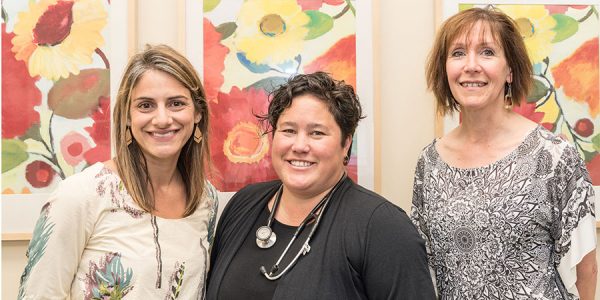Problem solving is hard-wired in for nurse practitioners at HealthConnection Clinic
While the Nurse Practitioners (NPs) that work at the North Shore’s award-winning HealthConnection Clinic (HCC) can be a diverse, interesting group of individuals, it’s clear they have one big thing in common: they love to solve problems.
It’s hard-wired into who they are and why they made the decision to become NPs, taking on the added responsibility of being the MRP (Most Responsible Practitioner) and all of the obligations that go along with that.
For HCC-newbie Michelle Sims, she’s still clear on what prompted her to shift to being an NP more than five years ago.
“As an RN (Registered Nurse) I felt like I was working inside a box,” she says. “As an NP, I feel like I’m able to work outside of that box and help people more than I could before because we’re always learning in this role and the scope of NPs continues to evolve in the system.”
A recent example of this growing role for NPs occurred late last year when they were granted the ability to prescribe controlled drugs such as analgesics or Suboxone. As the scope of practice broadens, the number of patients and families touched by NPs will also grow.
Sheila Turris, a long-time NP on the North Shore and with HCC is excited to see this continued growth and feels that the NP role has already come a long way in the nine years she’s been practicing.
“North Shore family physicians, specialists and NPs collaborate effectively in daily interactions,” she says. “And while some people are still a bit surprised by what we do – that we work in primary care as well as acute care for instance – I feel the gap in understanding is getting smaller all the time.”
Outreach holds promise for many reasons
Another factor that will help increase overall understanding of the NP role is a steady growth in outreach being planned for by HCC leadership.
It’s an area that HCC NP Jen Buck is already involved in as she spends one day per week working at the offices of the Tsleil-Waututh and Squamish First Nations, ensuring their members are cared for in an integrated fashion. And outreach is something she’s familiar with throughout her career, having spent 20+ years delivering health care in the high Arctic as both an outpost nurse and an advanced practice nurse.
Sheila, Jen and Michelle all see significant potential for outreach to more HCC patients. For the elderly and other vulnerable populations, maintaining stable access to medical care can be challenging if patients are always required to mobilize and get out of the house to receive care.
Although she’s the newest NP at HCC, Michelle’s clear on the value that efforts to lower barriers to care can have for marginalized populations as a result of working on the Downtown Eastside for more than five years.
“I remember one young guy we just wouldn’t get to the hospital or a clinic, despite the persistent medical problems he was experiencing,” she says. “But, with a lot of coaxing, we were able to get him tested for HIV and, once he was diagnosed and began treatment, his condition improved amazingly”.
“Once his viral load was reduced and controlled, he was able to manage his own treatments and is now successfully housed,” she adds.
Team approach at HCC pays off
While the often-dramatic nature of HCC patient turnarounds can be striking and are clearly motivating for people like Jen, Michelle and Sheila, all three of them are clear that the successes they’ve experienced as NPs are a result of more than just their own efforts.
“The team care approach we take here at the HCC is so important to our patients,” says Sheila. “From the Medical Office Assistants to the social workers, the chronic disease nurse and our dedicated family physicians, we all work together as a team.”
Jen also agrees, acknowledging the invaluable contributions their HCC colleagues make to caring for patients. One particular role that can go unnoticed is the effect that having a comprehensive health history can play in determining the proper course of care for a patient.
“In many cases, the patients we’re seeing have been accessing lots of care but the care has been disjointed and somewhat reactionary,” says Jen. “Working with the rest of our team, it’s extremely satisfying to sit down with a patient, consolidate their symptoms and treatment history and, in the span of a few visits, reduce their duplication of services and their confusion at the same time as we improve their health outcomes. And this takes solid teamwork because going through a 30-yr medical history and inputting it into our EMR isn’t easy.”
NPs in 10 years’ time
With the steady increases in the number and scope of practice for NPs at both the HCC and elsewhere, where does Sheila see things heading down the road? “I’d love to see what we’re doing here now become reproducible so that five to 10 years from now, interdisciplinary teams are serving 10 – 15,000 patients annually.”

